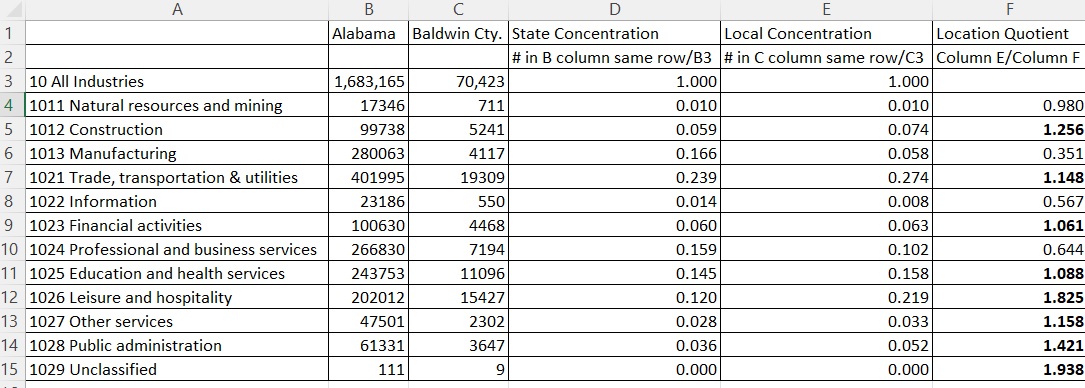Location Quotient Shows Local Economic Strengths
Last Updated: September 12, 2023
I recommend a relatively simple measurement called the location quotient as a great way to begin to understand a community's economic base.
The economic base consists of the businesses that bring net income to your community beyond what is consumed there. It's critical to understand and increase your economic base, which makes you prosperous.
Businesses that sell all or most of their product to locals, such as many restaurants and grocery stores, are vitally important to your quality of life, but not part of your economic base.
We know your chamber of commerce might talk as if all businesses are equally wonderful, but the truth is that the ones that bring in outside money are the economic activities that promise improved economic circumstances, not just running on a treadmill. The latest taco stand might be great, but unless it's so special that people visit from out of town, it does not form part of your economic base.
Rationale For Finding or Computing the Location Quotient

Figuring out the location quotient, sometimes simply written as LQ, in various ways is often an eye-opening experience for communities who want to understand more about their economic prospects.
The do-it-yourself economic base study has become relatively easy in the U.S., and the location quotient is often the first step in that. Typically the economic base study is done at the county level, although in large cities, please take a look at the MSA (Metropolitan Statistical Area) level instead.
Set aside some time to dig into the subject; this is going to take more than 5 minutes, OK? But if you have read this far, you can handle it.
The goal of the exercise is to find the economic sectors where the percentage of your total employment in a particular category exceeds your state's percentage or the national percentage in that category. Employment is used as an indicator of the entire economy.
Here we must pause to say that if we use the U.S. government tables described under the next heading, they also compute a "total hourly wages location quotient." My advice is that many extraneous things influence wages, so unless you are pretty sure that wages in your county are identical to wages in that industry in the state and in the nation, use the employment local quotient. Only bother with the other in specific instances where the income flow is more important than the absolute number of people working in an industry.
The sectors where you fall below the average may show opportunity for individual businesspersons, especially in the case of a retail category. This does not mean that retail counts toward the economic base.
As you know from school, a quotient is the result of a division problem. When dividing your local percentage of employment in a particular sector by the state or national percentage of employment in that same sector, you can identify your economic base by looking for those sectors where that quotient is larger than the number 1.
This means that your county's percentage of employment in that economic sector was greater than the percentage of employment in that sector in the comparison economy, either the state or nation.
Communities that wish to provide economic prosperity in the long run need to concentrate their business attraction efforts, support activities, and incentives on economic base activities rather than economic activity that serves the local population. If you as a citizen work with the online data we describe below, you'll be thinking in a more sophisticated way than a number of economic development professionals working for rival communities.
If you are in a country other than the U.S., your data sources and tools will be different, but you can still compare your location with larger regions and the entire country if you have the same data available for all three levels of geography.
How to Compute a Meaningful Location Quotient
In the U.S. the Bureau of Labor Statistics website provides relevant tables you download or print. The problem with that is that they assume you want to compare yourselves to the national economy, but that might not be the case.
Most communities where I've done these studies obtain the greatest insights through comparisons to their state.
However, sometimes people overlook the obvious, so if you're in a touristy state such as Florida, you might want to compare yourself to the U.S. to understand the full import of your tourism industry.
But if you want to see where you rank in terms of touristy Florida, compare yourself just to the state. Think about this example and you'll see the difference.
Below we will base our directions on the assumption that you will follow our recommendation to compare yourselves to your state's economy. As we said, if you are deciding to compare yourselves to the national economy for some reason, no math is needed; just record the number from the table.
Think of the location quotient in this way: It is the local concentration in an industry divided by the state concentration in an industry. So if your county's proportion of restaurant workers compared to all workers in your county is exactly the same as the state ratio of restaurant workers to all workers, your employment location quotient for restaurant workers is 1.0. If your location quotient is 0.5, you have a lower proportion of restaurant workers to all workers than the state economy shows.
If the location quotient is 2.6, you have about two and a half times the state's proportion of restaurant workers when compared to all workers.
1. Find a desktop computer, not a tablet or a phone. Go to this gateway page for the Bureau of Labor Statistics. (Unfortunately their direct page for the data you want did not appear reliably when we gave that URL, so we are giving you the workaround in what follows.) Click on Data Tools. Then under Charts and Applications, click Employment and Wages Data Viewer, and now you have arrived where you need to be.
2. Under Geographic Cross-Sections (the left column), select the third item, which is called "All Counties in a State, One Industry."
3. In the right column, select your state, your year (presumably this year or the latest year for which data is available), and then select the latest quarter available. Be mindful of the next choice, which is ownership type. In this example, we used private, meaning private enterprises, which is often the only choice you can make. There was one exception, which we will describe below.
4. Under Industry, select the first available item that has at least three digits, which right now happens to be 101, Goods-Producing.
5. Notice the gray box below the Industry list, Get Table. Before you click that, we recommend that you check the box underneath that, which asks if you want to obtain records with suppressed data. In this context, suppressed data means data that will not be published to protect confidentiality of businesses. This is common when there is only one business of a particular type in a county. You still will not obtain the data, but you will know that this is occurring because it is suppressed, not because there is no business that matches this industry type in the county. This can have some utility. For example, only two counties in Alabama had any employment in wheat farming. If the data is suppressed, at least you can see if your county had some undisclosed amount of that activity. If you don't check the box, you would not know if you had no results because there were no wheat farmers or because there were a few.
6. Now you are ready to click Get Data. You will find a table that includes the total U.S. employment and wages in that industry category, the state data, and then a list of all the counties in that state. The county data shows the employment in each of the three months in the quarter, then the total quarterly wages, the average weekly wage (of no usefulness in computing the location quotient, but maybe helpful for some purposes), and then their computed location quotient based on employment compared to the national economy in the last month of the quarter, and then what they call a total quarterly wages location quotient.
7. If you're decided you want to compare yourselves to the national economy, just pick up the number from the table and you're finished. If you want to follow our recommendation for most places and compare yourselves to your state, though, read on.
8. Now you have to decide how detailed your computations will be. The BLS table goes through only two types of what they call high-level industries, which are three goods-producing industries and nine service-producing industries. These correspond roughly to older two-digit general categories the Census Bureau used for many years. Then in the same table they launch into allowing you to select the much more fine-grained categories based on what are called NAICS classifications, which can have as many as six digits in them and feel very detailed. We suggest most of you begin with just the goods and services producing categories and stop before the ones that begin with NAICS. Then if it is really releant to your situaton to distinguish between strawberry farming and orange groves, for instance, you can move into the NAICS code data.
9. Let's say you decided to keep it simpler. Staying with that same table (all counties in a state, one industry), first record in a spreadsheet your county's and state's total employment numbers for the latest month for "10 Total, all industries."
10. Then find the first four-digit code in the table called Natural resources and mining. Highlight that and then check the box to show records with suppressed data, then click Get Table. Write down your county's employment number from the last month, and your state's number.
11. I skipped all good-producing, but you might want that also if you intend to compare goods-producing to service-producing.
12. Now that you have all of your numbers in an Excel or other spreadsheet format, compute your state's concentration in a particular industry. (In our example, divide the state's employment in 1011 Natural resources and mining by the state's employment in 10 Total all industries).
13. Then compute your county's concentration by dividing the 1011 category number by the 10 category number.
14. Lastly, make your spreadsheet work one more time by dividing your county's concentration by your state concentration. If the answer is more than 1, you have more of a concentration in that industry than does your state.
It sounds a lot harder than it is. See the picture below, where the bolded numbers in the far right column indicate the economic base of Baldwin County, Alabama. If you try this and get lost, contact us so we can walk you through it.

When you finish, you have to decide how much data analysis is enough. If you have a large county with a diversified economy, you may want to go through all or many of the NAICS categories; if you have a smaller county with just a relatively few types of businesses, and you are just being curious anyway, a more superficial analysis may do.
Read More To Help You Consider Your economic Strengths
- Making and Keeping a Good Community >
- Community Challenges, Common Topics & Concepts >
- Economic Development > Location Quotient
Join GOOD COMMUNITY PLUS, which provides you monthly with short features or tips about timely topics for neighborhoods, towns and cities, community organizations, and rural or small town environments. Unsubscribe any time. Give it a try.




